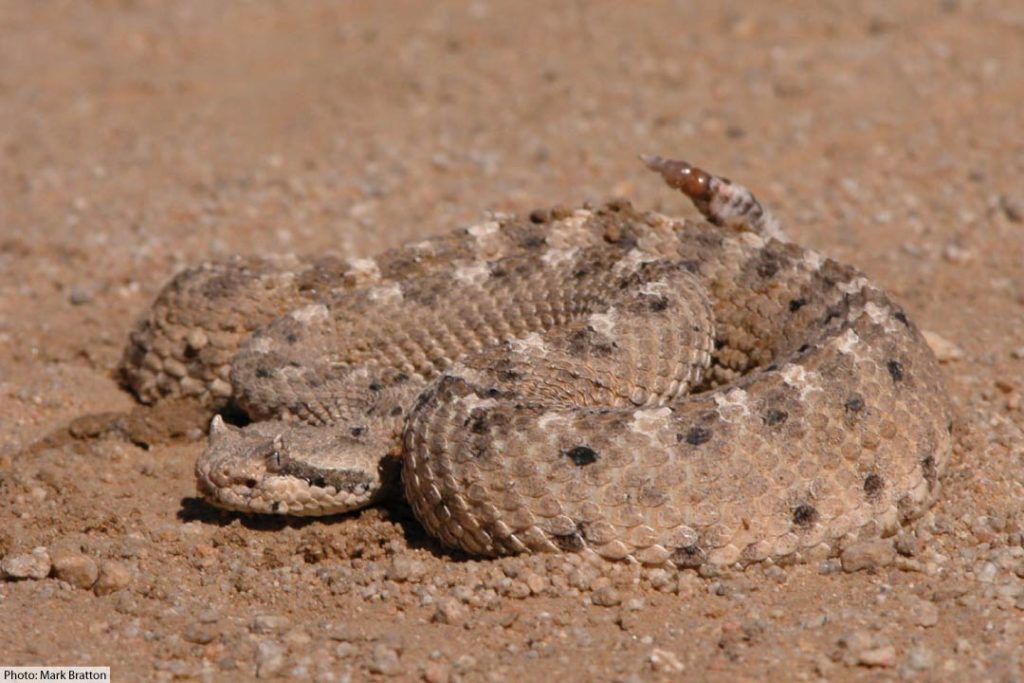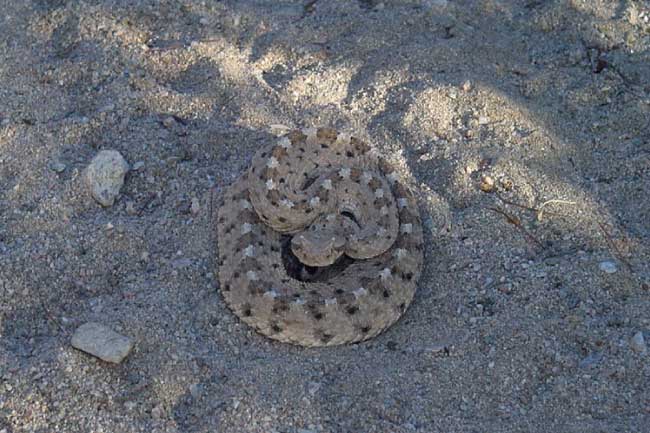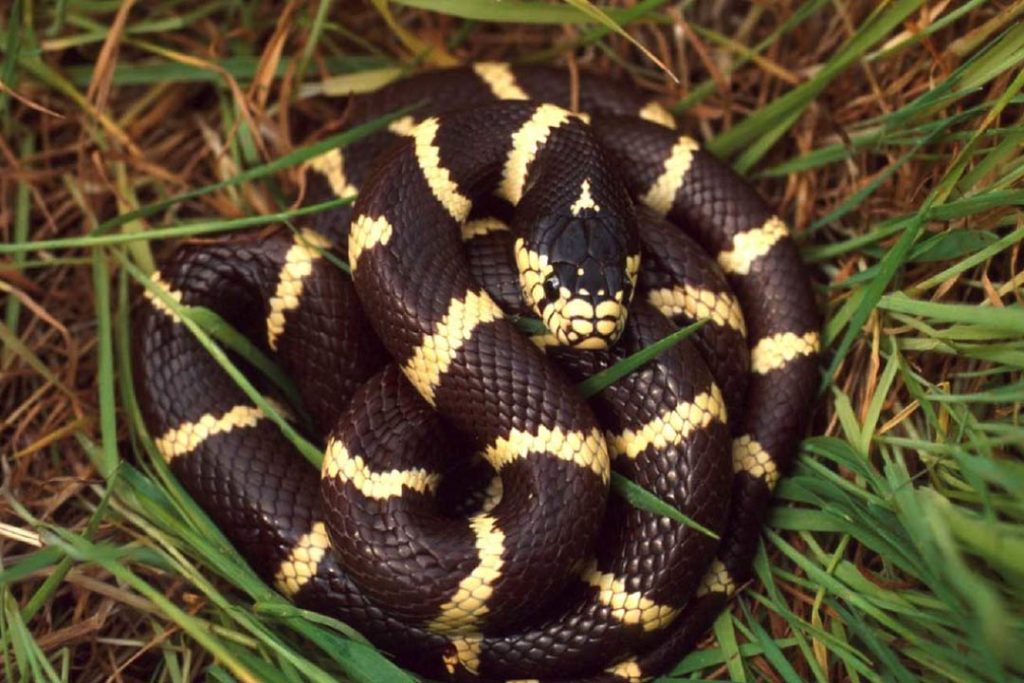Sidewinder facts for kids and adults. Discover a desert rattlesnake found in southwestern United States and north Mexico…
Sidewinder Facts At A Glance
- Other Name(s): Horned rattlesnake, sidewinder rattlesnake, Mojave desert sidewinder, sidewinder rattler
- Scientific name: Crotalus cerastes
- Type of Animal: Reptile
- Animal Family: Viperidae (Viper family); Subfamily: Crotalinae (the pit vipers)
- Where Found: Southwestern United States and northwestern Mexico
- Length: 43 to 76 cm (17 to 30 in)
- Weight: 94 to 304 g (3.3 to 10.7)
- Conservation Status: Least Concern
Other interesting sidewinder facts:
- The sidewinder is also known as the ‘horned rattlesnake’. This is due to the raised scales above its eyes, which resemble horns.
- Sidewinders are the fastest-moving rattlesnakes.
- Sidewinders give birth to live young rather than laying eggs.
- Sidewinders use their tails as lures to attract lizard prey.
Meet The Sidewinder: Introduction
The sidewinder is a small species of rattlesnake found in arid (dry) habitats in North America. The species has several adaptations for living in the desert, one of which is a distinctive sideways movement style known as ‘sidewinding’. It's this style of movement that gives the species its name. (You can find out more about sidewinding further down the page.)
Related Articles
- Reptiles: The Ultimate Guide
- Desert Animals List, With Pictures, Facts & FREE Question Sheet
- North American Reptiles List with Pictures & Facts
- View reptile books at our Natural History Bookstore
Sidewinder Subspecies
Currently, three subspecies of sidewinder are recognized: the Mojave Desert sidewinder (C. c. cerastes), the Sonoran Desert sidewinder (C. c. cercobombus) and the Colorado Desert sidewinder (C. c. laterorepens). Each is found in a different region of North America.
How To Identify A Sidewinder
The sidewinder has a thin neck and a broad, triangular head. It can be distinguished from other species of rattlesnake by the presence of horn-like scales above its eyes.
Scientists are unsure exactly why the sidewinder has these ‘horns’. They may help protect the snake’s eyes from sand, or provide shade from the sun.
A relatively small species of rattlesnake, the adult sidewinder is usually around 50 - 80 cm (19.5 - 31.5 in) in length. Unusually for rattlesnakes, female sidewinders are slightly larger than males.
The sidewinder is cream or sandy yellow/brown in color. The scales on the back and sides are keeled (ridged) and almond-shaped. The undersides are pale.
The snake’s sides are marked with a number of dark spots. Running along the back is a series of around 40 dark blotches. At the tip of the tail immediately before the rattle are one or more black bands. A line of darker scales extends from behind each of the eyes along the side of the head.
The snake’s coloration provides camouflage in the desert. The coloration of sidewinders varies from region to region, with snakes being a similar color to their surroundings.
Sidewinder Facts: The Rattle
Like other rattlesnakes, the sidewinder has a rattle made of hard, hollow scales at the tip of its tail. A new segment is added each time the snake sheds its skin.
When threatened, the snake vibrates muscles in its tail, causing the hardened scales to rattle against each other. The noise is thought to act as a warning to potential predators.
The number of segments in a rattlesnake’s tail is not a reliable indicator of the snake’s age; the segments at the tip of the rattle fall off at an uneven rate.
Where Is The Sidewinder Found?
The sidewinder is found in the southwestern United States and northwest Mexico. In the United States, the species' range covers desert regions of southeast California, southern Nevada, extreme southwestern Utah and southwestern Arizona.
In Mexico, the species is found in northeast Baja California, northwest Sonora and Tiburón Island.
Sidewinder Habitat
The sidewinder is usually found in open, sparsely vegetated areas such as sand dunes. It may also be found in areas with a relatively dense cover of vegetation, particularly if plenty of mammal burrows are present in the area. The species is also occasionally found in gravelly or rocky areas.
Sidewinders are present from sea level to elevations of up to 1,830 m (6,000 ft.).
Behavior
The sidewinder is nocturnal or crepuscular (active at dawn and at dusk) during the warmer months.
When the temperature is cooler the snake switches to a diurnal (active during the day) lifestyle. In some areas, sidewinders hibernate during the coldest part of the year.
The snake is inactive for several days after consuming prey and also before shedding its skin.
During periods of inactivity, the snake seeks shelter under vegetation, burying itself in the sand by wriggling its body. It will also take shelter in a rodent burrow.
The sidewinder is solitary and territorial. Males have larger home ranges and tend to travel over greater distances than females.
Sidewinding Movement
You can see the sidewinder's distinctive sidewinding style of movement in the video below:
The sidewinder gets its name from the distinctive way in which it moves. Sidewinding is a method used by a number of desert snakes in order to travel over loose sand.
While sidewinding, only two parts of the snake’s body are in contact with the sand. The snake anchors itself with its tail and throws its head forward. The tail is then brought up behind the head and the motion is repeated.
Sidewinding is the fastest way a snake can move. It also reduces physical contact with the hot sand. There are reports of sidewinders being able to travel at up to 18 mph (29 km/h) while sidewinding.
Sidewinders are also capable of moving in the usual snake-like manner. However, sidewinding is the method of locomotion most commonly used by the species.
Sidewinder Facts: Life-Cycle
Mating takes place between April and July. Female sidewinders require warm temperatures and sufficient food to reproduce, and may avoid mating in years in which conditions are unsuitable. Male sidewinders often have to travel extensively in search of females.
Courtship involves the male rubbing the female with his chin and wrapping his tail around hers.
The female gives birth to between 5 and 18 live young inside a rodent burrow. The newborn snakes are covered in a thin membrane which they break through immediately after being born. The female stays with her young for around 3 hours after giving birth.
Giving birth is costly in terms of energy used, and can leave the female dangerously exhausted. Female sidewinders have a significantly shorter life span (about 5 years) than males (up to 13 years).
The young remain in their natal burrow for 7 to 10 days. The bundled mass of newborn snakes closes the entrance to the burrow and regulates the temperature inside. At the end of this period they shed their skins for the first time before leaving the nest.
How Do Sidewinders Hunt?
The sidewinder is an ambush predator. It buries itself in the sand and waits for prey to approach before striking and immobilizing its victim with its venom. The venom is injected via the snake’s hollow, retractable fangs.
The sidewinder can detect infrared radiation given off by its prey using special organs in its head. These heat-sensing organs are contained in a pit located on either side of the snake’s head between the eye and the nostril.
This feature is common to all pit vipers and is what gives the group its name.
Using this ‘sixth sense’, the snake can detect the location of its prey. It is also thought that, using its pit organs, the snake can judge the size of potential prey.
Like other rattlesnakes, the sidewinder has an acute sense of smell. The snake can smell using its nostrils, and also by flicking its tongue. This action directs chemicals in the air to a special smell-sensing organ located in the roof of the snake’s mouth. This organ is known as the vomeronasal organ, or Jacobson's organ.
Juvenile sidewinders have been observed using their tails as lures in order to capture lizard prey.
A slow movement of the tail may simulate a worm or caterpillar, whereas a fast movement may simulate a fluttering moth.
With the rest of the snake’s body camouflaged, an inquisitive lizard will approach the tail, believing it to be an item of food. When the lizard comes within range, the snake will strike, capturing the lizard in its jaws.
Using the tail in this way is known as caudal luring (caudal meaning ‘of or like a tail’). The black bands at the tip of the sidewinder’s tail may increase the effectiveness of this behavior.
Caudal luring is not seen in adult sidewinders.
What Do Sidewinders Eat?
The sidewinder’s diet includes various desert reptiles (including lizards and other snakes), small mammals, and occasionally birds.
During the winter, lizards form the bulk of the snake’s diet. Mammals are consumed in greater quantities in late spring and summer when the snake hunts at night.
Sidewinder Predators
Sidewinders are targeted by a number of predators, with juveniles being particularly at risk. Sidewinder predators include birds such as crows, hawks and shrikes, snakes such as the California kingsnake, and mammals such as raccoons and coyotes.
When threatened, the sidewinder will shake its rattle and attempt to give the impression of being larger than it actually is. It may also bite in self-defense.
Is The Sidewinder Dangerous To Humans?
The desert-dwelling sidewinder is rarely encountered by humans. Its venom glands are smaller than those of larger rattlesnakes, and its venom weaker. Despite this, a sidewinder bite can still be extremely painful and potentially life-threatening. If bitten, treatment should be sought without delay.
Is The Sidewinder Endangered?
The sidewinder is rated ‘Least Concern’ by the IUCN.
The species has a wide distribution range that includes many protected areas. The estimated population (over 100,000 adult snakes) is thought to be stable, and no major threats have been identified.








seen a sidewinder in fallbrook ca on my driveway about 16 inches long. when I stopped to take a video it took off in the long grass.
Great sighting, thank you for letting us know.
Regards,
The Active Wild Team
they are a cool snake
Sidewinders occur well BELOW sea level, in places like Death Valley and the Coachella basin. Up to 280 feet below!
We saw one 2 days ago in Eugene Oregon, a baby one. It was very aggressive!
test